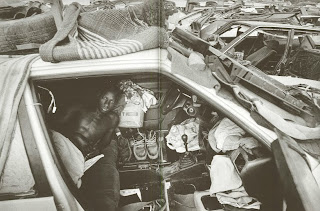Alex Couto
Art 309
March 19, 2010
Sebastiao Salgado: Migration and Globalization
The black and white photographs taken by Sebastiao Salgado illustrate his ability to visualize the homogeneity of the “third world” brought about negative impacts of globalization. A major issue that prevails in his work is the complex relationship between the developing and developed worlds. Poverty, migration, and the environment are also prevalent topics within Salgado’s work. Salgado is known and “famous for putting a human face on economic and political oppression in developing countries.”(1)
Salgado, Sebastiao. Gibraltar, a Border Between Two Worlds. 1997
“Migrations,” a six year project of black and white photographs initiated in 1993 by Salgado, depicts and clarifies how globalization has impacted developing nations. He touches on the subjects of refugees and of identity (or lack of) in this series as well. Salgado mentions: “few people uproot themselves by choice, most are compelled to become migrants refugees, or exiles by forces beyond their control, by poverty, repression, or war.”(2) The “migrations” series also illustrates the homogenization between these third world countries. Not the form of homogenization generally accompanied with globalization, the form of a unifying “western style” culture based on capitalism, individuality, and materialism, but a homogenization of despair. Gibraltar, a Border Between Two Worlds clearly illustrates this idea of homogenization of despair and poverty. This photograph, taken in 1997, at Camp “Granja Agricola” near the airport of Melilla, shows how this man might have lived at this specific point in time. Undoubtedly a migrant, this man has become a nomad seeking his refuge on the other side of the border. This photograph, like many others of this series, shows in plain view how globalization and crippling poverty can affect a person.
Salgado describes how he came to the realization that we are all “affected by the widening gap between the rich and poor”(3) and that migration is but only the most visible form. Salgado continued by saying that he would sometimes forget in which city he was actually in and described how all these cities began to mesh together in a homogenous way. “Everywhere there are those same islands of wealth amid the poverty, like the green areas of Manila that are private golf clubs instead of public parks.”(4) Also, Salgado believes that this worldwide upheaval and displacement of peoples are caused by essentially the same reasons. The message being made in this series is the idea that throughout the world, rural poverty has promoted the migration of millions of peasants from the countryside to a more urban landscape. Political and economic purposes, as well as civil war are also clear motives for migration in his photography. This photograph, U.S.- Mexico Border, taken in 1997 in Tijuana, shows once again someone on the move as well as someone who is suffering. However in this case you can see a large wall has been put up to prevent these migrations of people. This image clearly shows the “action” and “reaction” of these vast amounts of people trying to make their way into the U.S.
Salgado, Sebastiao. U.S. - Mexico Border. 1997
This series not only depicts migration from the countryside to the cities or just migration of peoples from one country to another, he also demonstrates the migrations of peoples from developing countries to the developed. Salgado makes it clear that both the identity of the migrant, the home country as well as the host country all transform through migration. The US in becoming more “hispanisized” with the migration from it’s southern neighbors as well as Europe becoming more intertwined with it’s Middle Eastern and African neighbors. However all migrants are driven by the force of beginning a new, and seeking prosperity somewhere else.
Salgado, Sebastiao. “Passage Through Mexico.” 1998
“Refugees, unlike migrants, are not dreaming of different lives,”(5) according to Salgado. He mentions that these are ordinary people who have been stripped of their homes, jobs and sometimes loved ones. However they are also stripped of their identities. Instead of people who are stable in one place they become people “on the run” and in “exchange for survival, they must surrender their dignity.”(6) This photograph shows the volume and amount of people that can accumulate and any given time between the borders. Passage through Mexico illustrates what the border between Guatemala and Mexico may look like if you ever encounter it.
Salgado’s new project “Genesis,” currently in the works, is a “visual story about the effects of modern development on the environment. Yet rather than document the effects of, say , pollution or global warming directly, he is photographing natural subjects that he believes have somehow ‘escaped or recovered from‘ such changes.”(7) This series is much different than that of his other work. In the past it has been photographs of people where in this project it is that more of animals, seascapes and animals. However with the same underlying issues of how in his own words, “globalization is presented to us as a reality, but not as a solution.”(8) The idea that the third world in particular is becoming more homogenized in the form of poverty, inequality and in the destruction of the environment.
Salgado has always “sought to use his photographs to inform the global consciousness. He has been as insistent witness to the injustices of social systems.”(9) Sebastiao Salgado may have illustrated the horrors of the world in his work, he has also shown the beauties of it through his lens as well. He also portrays the idea that people are becoming more homogenous in the reaction to these hardships and how they can unite to better themselves and each other.
Works Cited
Salgado, Sebastiao. Migrations:Humanity in Transition, Chapter I: Migrants and Refugees: The Survival Instinct. Aperture, June 15, 2005.
(2)(3)(4)(5)(6)(8)
Finkel, Jori. “Back to Nature, in Pictures and Action.” New York Times. (5/31/2009): p26
(1)(7)
N/A. “Toward the End, Genesis.” Earth Island Journal. Vol. 24 Issue 4 (2010): p31-33
(9)


